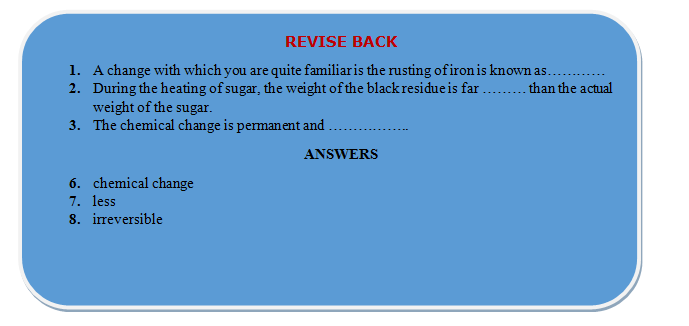
Chemical Change
Physical and chemical change of Class 7
Definition ofChemical Change
Chemical change is a permanent change which cannot be reversed and in which the chemical properties of a substance change with the change in its composition. It also alters the specific properties of a compound by bringing about a change in its molecular composition followed by a change in state,
All of us are familiar is the rusting of iron. If we leave a piece of iron in contact of air for some time, it is observe that the piece of iron acquires a film of brownish substance. This substance is called rust and the process is called rusting. Iron gates of parks or farmlands, iron benches kept in lawns and gardens, almost every article of iron, kept in the open gets rusted. At home you must have seen shovels and spades getting rusted when exposed to theatmosphere for some time.
Characteristics of a Chemical Change:
- Change in mass of the substance occurs during a chemical change. However, total mass of all the reactants and products remain unchanged.
- The composition of a substance changes during a chemical change.
- Either heat is absorbed or evolved during a chemical change i.e., chemical change is either exothermic or endothermic.The different atoms in a chemical compound are joined by attractive forces commonly called bonds. The formation or breaking of the bonds always requires exchange of energy.
- The chemical change is irreversible and permanent,It means that the change will not reverse by altering the experimental conditions.
Example:
The sugar molecule which has decomposed on heating and form carbon and steam will not change to sugar on cooling.
Examples of Chemical changes
- Rusting of an iron knife.
- Burning of a candle.
-
Digestion of food.
Obviously, the rust cannot be converted back into iron, the burnt products i.e., carbon dioxide and water, cannot form wax and the products formed on digestion cannot be brought back into the original food. - Burning of wood or charcoal.
- Decomposition of water into hydrogen and oxygen.
- Formation of water from hydrogen and oxygen
- Curdling of milk.
Some Examples Involving Chemical Changes:
| Chemical change | Observation | Equation |
| 1. Burning of magnesium in air | When a magnesium ribbon is heated in a flame of Bunsen burner, it catches fire and burns with a dazzling white flame to form white ash. | Magnesium + Oxygen ® Magnesium oxide |
| 2. Rusting of iron | When iron (silver grey) is left exposed to moist air for a fewdays, reddish brown powdery mass (rust) is found on its surface | iron + Oxygen from air+ Water vapour® Rust Butane |
(c) Difference between Physical and Chemical Changes
Different Example of Physical and chemical change
| Physical change | Chemical change |
| Ripening of fruit | Baking of cake |
| Formation of biogas | Formation of methane in marshy areas |
| Clotting in blood | Drying of paint |
| Burning of LPG gas |










